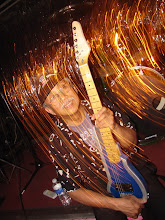
Press Release: September 12, 2006
What: Oteyza and Oteyza, Tatay at Anak (Father and Son) Art Exhibit
Where: Philippine Center Gallery, Philippine Center, 556 5th Ave., New York, NY 10036 (212) 575-4774
When: September 25 – October 6, 2006
Opening Reception: Monday, September 25, 2006, 6 – 8 pm
This is the second father and son show featuring the combined artistic talents of Victor (father) and Julian Oteyza (son) in the United States. The first was held in the Philippine Embassy in Washington, DC, when the Honorable Excellency Raul Rabe welcomed a standing room only crowd to the exhibit launch.
This current exhibit features the work of Victor Oteyza, one of the 13 moderns who began the modern art movement in the Philippines. Victor’s work originated from an extensive study of philosophy and was a physical manifestation of his goal to portray the creativity of the modern (1950’s) Filipino in a manner that broke the mold of the posed portraits and copies of art masters. Victor was a writer, director, perpetual student of the universe and his experiences translated the lessons he learned into modern art. Through the experience of growing up in the Philippines, visiting the provinces, producing plays, radio shows and engaging in philosophical discussions with his kababayan (countrymen) he had a basis for the expanded sensory journey of visiting Europe and exploring the United States and that experience manifested in some of the most incredible art Victor every created.
Julian Oteyza’s life experience also began in the Philippines where he was surrounded by an extensive support network of family and friends, intense colors in everyday objects such as tropical birds, fish, flowers and the ocean and sky in both Baguio where he was born and Manila where he attended school. Julian’s art emerged from his innate curiosity and an inventive streak that led him to create his own style of expression on canvas and in the patent he holds on a travel guitar. Julian’s art work rotates, emerges, pulsates, appears in layers, joins together to form film clip style time frames and is interactive with the viewer. Julian’s body of art work offers the viewer tactile involvement. Since Julian has been in the United States he has created work that has been featured on both coasts of the country. He has also exhibited in India, Egypt and of course in his bayan (homeland), The Philippines.
This show offers a spectrum of artistic expression by father and son and covers the time frame of the 1950’s to 2006 the year of the Philippine Centennial.
Victor spent a lot of time experimenting with different materials. He saved polystyrene plates that came with meat packaging and melted them with a blowtorch into various shapes which he thought he might be able to incorporate in his paintings. He used hairdryers, fans and straws to blow paint across his canvas to create the shapes he envisioned.
Julian built unique mechanisms in some of his works that helped convey what he wanted to the viewer, often requiring them to touch the paintings and manipulate the frames to create an appealing configuration. His motivation was to involve the viewer with the art and offer a different perspective to each person.
This year, the centennial year celebrating the 100 years that the Filipinos have been in the United States, Julian went back to basics and chose to create traditional paintings portraying scenes reminiscent of his childhood and the life of the present Filipino-Americans living in the United States. He traveled to Hawaii last December where he connected to the past as this is where the first Filipinos, Sekadas, landed. From there he captured images of everyday life and objects to create a series of paintings illustrating the passage of time. These paintings are displayed in frames Julian created and built to simulate a film clip capturing a moment in the time. This exciting new series depicting moments frozen in time is entitled “Time Frames”.
The Julian and Victor show, represents very different motivations and manifestations of artistic expression. This exhibit connects philosophically and spiritually: two minds, two individual styles, two generations, two different time frames, two different means of expression that combine to support one goal. The goal is to celebrate eternal life by sharing beauty, color, love, harmony, innovation, creativity, passion, strength, joy, evolution, and originality through art.
The Neo-Realists
The "creation of a new reality"—this was the battle cry of the original group of painters that called themselves "Neo-Realists" —Hernando R. Ocampo (1911-1978), Ramon Estella (1911-1991), Vicente Manansala (1913-1981), Victor Oteyza (1913-1979), Cesar Legaspi (1917-1994) and Romeo Tabuena (born 1926). (Except for Estella, all these original members have paintings in this exhibit). The Neo-Realists (who were also called "modernists" or Philippine Art Gallery (PAG) artists because they exhibited in Lyd Arguilla's "biggest little room" on Arquiza St.) desired to look at reality "with new eyes." They soon expanded into a bigger group which included Manuel Rodriguez Sr., Nena Saguil, Anita Magsaysay-Ho, Fernando Zóbel, Arturo Rogerio Luz, J. Elizalde Navarro, Jose Joya, Lee Aguinaldo and David Cortez Medalla .
To be called a "modern" or "Neo-Realist" painter then is not to re-present, depict or illustrate scenes of modern life. It is to present reality in a new way, to create it anew in such a way that the lived presence of the artist is felt in the painting itself. There is no other access to the painter except through his painting which is his expression or text.
Information: Julian Oteyza . joteyza@verizon.net . (703) 969-5469
http://www.guitaround.com/ . http://julianoteyzaart.blogspot.com/
http://victoroteyza.blogspot.com/


0 Comments:
Post a Comment
<< Home